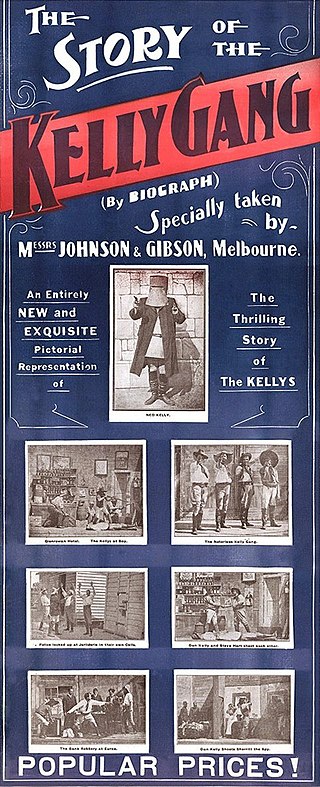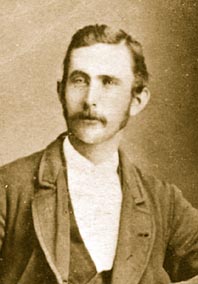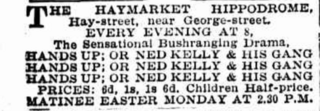Related Research Articles

The Story of the Kelly Gang is a 1906 Australian bushranger film directed by Charles Tait. It traces the exploits of the 19th-century Kelly gang of bushrangers and outlaws, led by Ned Kelly. The silent film was shot in and around Melbourne and originally ran for more than an hour with a reel length of about 1,200 metres (4,000 ft), making it the longest narrative film yet seen in the world.

Edward Kelly was an Australian bushranger, outlaw, gang leader and convicted police-murderer. One of the last bushrangers, he is known for wearing a suit of bulletproof armour during his final shootout with the police.

Joseph Byrne was an Australian bushranger, outlaw and member of the Kelly gang, referred to as leader Ned Kelly's second in command.

The Kelly Gang is an Australian feature-length film about the Australian bush ranger, Ned Kelly. The film was released in 1920, and is the second film to be based on the life of Ned Kelly, the first being The Story of the Kelly Gang, released in 1906.

Daniel Kelly was an Australian bushranger and outlaw. The son of an Irish convict, he was the younger brother of the bushranger Ned Kelly. In 1878, Dan and Ned killed three policemen at Stringybark Creek in northeast Victoria, near the present-day town of Tolmie, Victoria. With two friends, Joe Byrne and Steve Hart, the brothers formed the Kelly Gang, which robbed banks, took over whole towns, and terrorized the people of Victoria and New South Wales for two years. The Victorian police searched for them, locked up their friends and families, but could not find them. Dan Kelly died during the infamous siege of Glenrowan in June 1880.

Robert Mainwaring Chitty was an Australian rules footballer in the Victorian Football League (VFL).
Rupert Kathner (1904–1954) was an Australian film director best known for newsreels and low-budget films. He worked with Alma Brooks, an ex-barmaid, who co-produced, operated the camera, edited, co-scripted and acted in their films. Kathner and Brooks were also "shady con artists and fugitives from the law", sometimes described as the "Bonnie and Clyde" of the Australian film industry.
The original Benalla District Football League was formed in 1929 from the following clubs - Baddaginnie, Benalla - "B", Swanpool, Tatong, Thoona and Winton.

Winton is a locality near Benalla, Victoria, Australia.
Phantom Gold is a 1937 Australian adventure film about the search for Lasseter's Reef. It was the first feature from director Rupert Kathner.
Harry Southwell was an Australian actor, writer and film director best known for making films about Ned Kelly. He was born in Cardiff, Wales and spent a couple of years in America, where he adapted some short stories by O Henry into two reel films. He worked for Vitagraph in the United States for five years, then moved to Australia in 1919, where he used his experience as a screenwriter to impress investors to back him making features. He set up his own production company in Australia but few of his movies were commercially successful.
When the Kellys Rode is a 1934 Australian film directed by Harry Southwell about Ned Kelly.
When the Kellys Were Out is a 1923 Australian feature-length film directed by Harry Southwell about Ned Kelly. Only part of the film survives today.

Ned Kelly was a 19th-century Australian bushranger and outlaw whose life has inspired numerous works in the arts and popular culture, especially in his home country, where he is viewed by some as a Robin Hood-like figure.
The Kellys of Tobruk was a comedy feature film directed by Rupert Kathner which was meant to be released in 1942. Advertisements were placed in newspapers in January 1942 claiming pupils at their acting school could get roles in the movie. The film appears to have been abandoned after Kathner's company, Fanfare, was taken over by Supreme Sound System.
The bushranger ban was a ban on films about bushrangers that came into effect in parts of Australia in 1911–12. Films about bushrangers had been the most popular genre of local films ever since The Story of the Kelly Gang (1906). Governments were worried about the influence this would have on the population and bans against films depicting bushrangers were introduced in South Australia (1911), New South Wales and Victoria (1912).
J. J. Kenneally was an Australian journalist and trade unionist. An early populariser of Australian bushranger Ned Kelly and his gang via his book The Inner History of the Kelly Gang and Their Pursuers (1929), he was also one of the original members of the country's Labor Party and later formed his own party.
Ned Kelly is a 1959 Australian television play adapted from the radio play of the same name.

Hands Up, or Ned Kelly and His Gang is a 1900 Australian play by Edward Irham Cole about Ned Kelly.

Thomas Curnow was an English-born Australian schoolteacher who helped prevent the derailment of a police train by the Kelly gang, led by bushranger and outlaw Ned Kelly. Curnow's actions are credited with saving the lives of 27 passengers, including civilians.
References
- ↑ "Advertising". The Sydney Morning Herald . National Library of Australia. 17 August 1951. p. 13. Retrieved 23 August 2012.
- ↑ "Candid Comment". The Sunday Herald . Sydney: National Library of Australia. 6 April 1952. p. 2. Retrieved 23 August 2012.
- ↑ "AN IDEA NOW BECOMES A REALITY". Benalla Ensign . Vic.: National Library of Australia. 29 August 1947. p. 1 Edition: MORNING. Retrieved 23 August 2012.
- ↑ "FORMER FOOTBALLER TO STAR IN FILM". Sunshine Advocate . Vic.: National Library of Australia. 26 September 1947. p. 1. Retrieved 23 August 2012.
- ↑ "Film Flash". Benalla Ensign . Vic.: National Library of Australia. 3 October 1947. p. 5 Edition: MORNING. Retrieved 23 August 2012.
- ↑ "Kelly gang rides again". The Argus . Melbourne: National Library of Australia. 1 April 1952. p. 6. Retrieved 23 August 2012.
- ↑ "Ned Kelly Epic to Boost Australia". Benalla Ensign . Vic.: National Library of Australia. 10 October 1947. p. 1 Edition: MORNING. Retrieved 23 August 2012.
- 1 2 Andrew Pike and Ross Cooper, Australian Film 1900–1977: A Guide to Feature Film Production, Melbourne: Oxford University Press, 1998, 212.
- ↑ "COMPANY NEWS". The Argus . Melbourne: National Library of Australia. 1 June 1948. p. 6. Retrieved 23 August 2012.
- ↑ "Advertising". Benalla Ensign . Vic.: National Library of Australia. 28 November 1947. p. 5 Edition: MORNING. Retrieved 23 August 2012.
- ↑ "Kelly Gang Will Fly To Sydney". The Sydney Morning Herald . National Library of Australia. 13 January 1948. p. 3. Retrieved 23 August 2012.
- ↑ "KELLY GANG FILM". The Sydney Morning Herald . National Library of Australia. 6 January 1950. p. 4. Retrieved 23 August 2012.
- ↑ "..REVIEWS OF NEW FILMS IN SYDNEY." The Sunday Herald . Sydney: National Library of Australia. 19 August 1951. p. 12. Retrieved 23 August 2012.
- ↑ "Bang! Bang! Again the guns rang out, and one by one they fell, the — Kellys, riddled with laughter". The Argus . Melbourne: National Library of Australia. 4 April 1952. p. 1. Retrieved 23 August 2012.
- ↑ "'Glenrowan Affair' Raises £400 for Fire Victims". Benalla Ensign . Vic.: National Library of Australia. 10 April 1952. p. 4. Retrieved 23 August 2012.
- ↑ Michael Adams, Showgirls, Teen Wolves, and Astro Zombies : a film critic's year-long quest to find the worst movie ever made.New York : Itbooks, 2010. ISBN 978-0-06-180629-2 (p.144)
